|
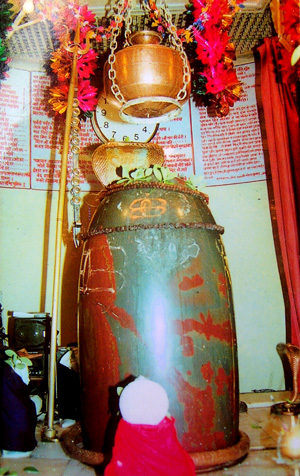 |
Shankaracharya
Temple
Srinagar, Kashmir |
 |
|

The Shiva Lingam |
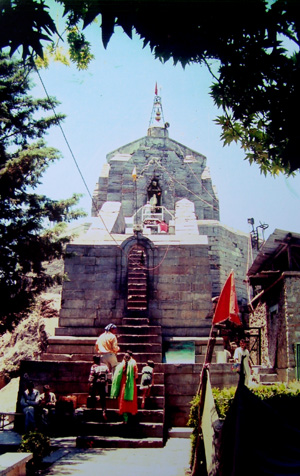
The temple |
|
As
it is not permitted to bring camera to the tempelsite, these photos of
the temple are taken from postcards. |
|
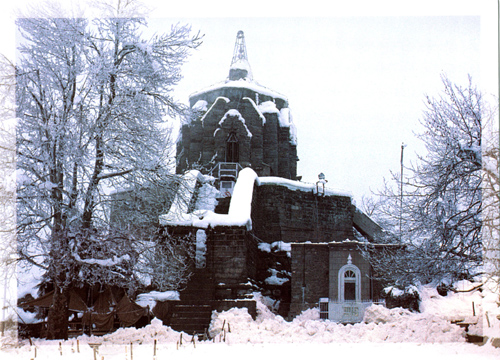
Postcard showing the temple on
the Shankaracharya Hill,
"Takht-i-Sulaiman or the "Throne of Solomon".
|
|
The Sankaracharya Temple |
|
The
ancient Sankaracharya Temple, also known as the Jyesteswara Temple,
is found on top of the hill Takht-i-Sulaiman or "Throne of Solomon",
at the hight of 350m. Overlooking the lake, Adi Shankaracharya
(788-820AC) lived, meditated and did Tapas (penance) here to review
Hinduism which had been eclipsed by Buddhism. He worshipped the
Shiva Lingam, which is still found in the Sanctum Sanctorum.
Information bords on the spot tells, that Adi Shankaracharya
"attained spiritual knowledge" at this particular place and after
that went out and formed the four Hindu schools of Advaita, the
philosophy of non-dualism.
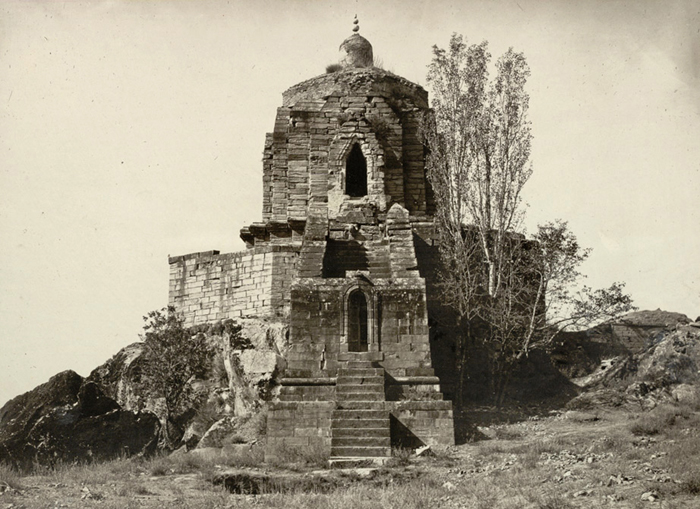
The Sankaracharya
Temple in 1868 |
|
History |
|
The
temple was
built by Jalauka, the son of the great Emperor Ashoka, about 200
B.C.
King Gopadatta of Kashmir who ruled from 79 to 109AD, rebuilt it and
dedicated the temple to Jyesteswara.
The hill was called Gopadri and the
village at its foot on the south is still called Gopkar.
Mulla Nadri
writes in the first history of Kashmir, "Tarikh-i-Kashmir",
1420AD:
"Raja Ach
ascended the throne and ruled for 60 years. He founded the town of
Achabal in Kotiar, Kashmir. After his death, his son Gopananda ruled
the country, under the name of Gopadatta. During his reign many
temples were built and repaired. At that time the dome of the temple
on the top of Solomon hill had cracked. He asked one of his
ministers, named Sulaiman, who had come from Persia, to repair the
cracked dome of the temple. On this, the local Hindus raised
objections saying that as Sulaiman was an infidel and followed
another religion, he had no right to repair the sacred temple of the
Hindus.
During this very period,
Hazrat Yuzu Asaph arrived from the Holy Land, Bait ul Maquaddas, to
the Holy Valley, Wadi a Aqddas, and proclaimed his ministry. He
absorbed himself in prayers day and night, and having attained an
elevated position in virtue and piety, he declared to the people of
Kashmir that he was the messenger of God. He called upon the people
to follow the words of God, and many believed in him. Thereupon,
Raja Gopadatta referred the objections of Hindus to him for his
decision. It was under his orders that Sulaiman, whom the local
Hindus named Sandiman, completed the repairs of the cracked dome of
the temple, in the year 54. Sulaiman also had engraved the following
inscriptions on the stones leading to the stairs of the temple:
"During this period Yuzu Asaph declared his Ministry. He was Yusu,
the Prophet of the Children of Israel".
In a work by a Hindu
it is said that this Prophet was in reality Hazrat Issa, the Soul of
God - on whom be peace and salutations. He had assumed the name of
Yuzu Asaph during his life in the valley. The real knowledge is with
Allah. After his demise, Hazrat Issa, on whom be peace and
salutations, was laid to rest in the tomb in the locality of Anzimar.
It is also said that the rays of prophethood used to emanate from
the tomb of this Prophet. Raja Gopadatta passed away after having
ruled for 60 years and 2 months."
The
present struture probably dates back to the 9th century AD and are
dedicated to Lord Shiva.
The temple was renamed Sankaracharya, under a Hindu Maharaja
in 1848.
|
|
Architecture |
The temple is built in early Kashmiri
style. It tries to introduce the early Sihara style and has still
one-storeyed gable pediment which is evident even now. The temple is
an early specimen of the horse shoe arch, prominent in the final
stages of this architecture, as, for example, in Martand.
It is said that massive polished steps was leading right from the
Jhelum River up to the top of the hill. These stones were removed in
the 16th century by Muslim rulers and used for the construction of a
mosque. |
|
Did Jesus visit the temple? |
It is very
likely that both Jesus Christ (and his disciple Thomas) have been at
this age old temple. Inscriptions on the stairs leading up to the
shrine supports this notion. Scriptures and other indications
proves beyond doubt that Jesus has been in Srinagar and maybe even
lived there for a while, as Srinagar in those days was a very
important religious and cultural center.
His burial at the Rozabal
Mausolaeum also indicates that
he had a strong connection to this particular place.
|
|
The four Persian inscriptions at the stairs |
|

The text of the inscriptions:
1. The mason of this pillar is Bihishti Zargar (artisan under
Sandiman), year fifty and four. (inscription above)
2. Khwaja Rukun son of Murjan erected this pillar.
3. At this time Yuz Asaf proclaimed his prophethood. Year fifty
and four (=78AD).
4. He is Jesus, prophet of the children of Israel.
Historians believe that before the temple was built there used to be
a mosque. Nearby the temple some scattered traces of a mosque can be
found and
short distance from the temple there are some graves hidden in the
grass. These are supposedly the graves of Hebrew artisans employed
by Sulaiman in repairing this temple. |
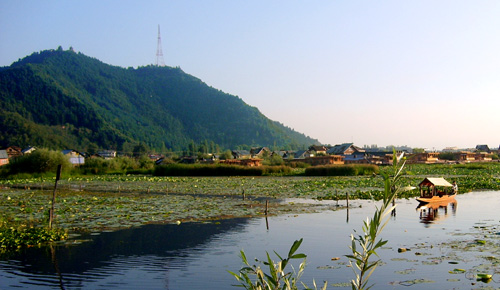
The Shankaracharya Hill and Dal
Lake in the summer season
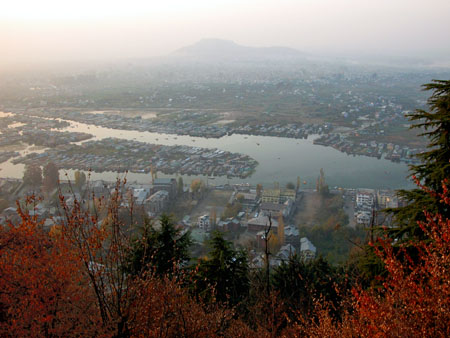
Dal Lake in autumn colours with houseboats side by side,
seen from the Shankaracharya Hill,
"Takht-i-Sulaiman or the "Throne of Solomon".
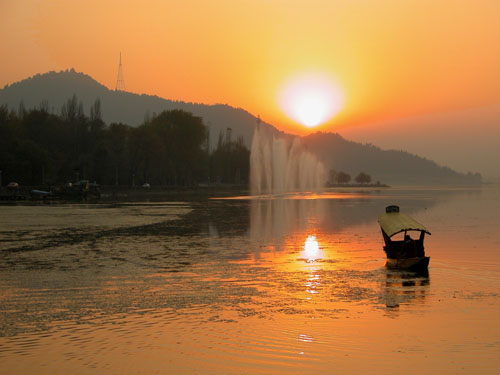
Sunset over Dal Lake with Shankarachaya or Solomon Hill in the background.
|
Faith and/or facts? |
| The pages on this website about Christ in Kashmir
are based upon the assumption, that Jesus survived the crucifixtion.
Fleeing from His grave, Jesus went in hiding from the Romans and other
persecuters outside
Jerusalem.
After recovering from His wounds, He travelled incognito, perhaps even
under a another name, with caravans along the "Silk Road", the ancient
trade route from Europe to the far east. Yuz Azaf or Jesus Christ arrived in Kashmir aproximately year 60AD. He
stayed in Kashmir,
where many other Israelites lived. Ten of the twelve tribes of Israel had migrated
to this "Promised Land", in the 6th century BC, ie. long time before
the birth of
Jesus.
Jesus came because he was the Messiah of the Israelittes, and he has, in
clear words, declared that: "He was sent to serve the lost sheep in the
house of Israel.".
After year 80AD he was entombed in Srinagar.
These assumptions is based on several scriptures: The apocryphal texts and
non-canonized gospels found in Qumran, Israel and Nag Hamadi, Egypt,
scriptures found in Tibetan monestaries, historians over the centuries,
inscriptions in temples and at the Rozabal Mausolaeum, the Sanskrit
texts Bahavishya Maha Purana and Rajatarangini, Persian texts and last but not the least: The age old oral tradition from the different parts of India
and other countries, where Jesus is supposed to have been. Where the
local people long time ago had seen a man, "With fair hair and a face
shining like the sun, who called Himself, the son of God."
Jesus
Christ was an enlightend master without attachments of any kind to
either places, people or things. He was a travelling saint, who spread "The
Word" Himself. The knowledge about "The Kingdom to come", which
is as difficult to understand today, as it was for His closest disciple,
he taught himself. It is
likely and very well documented, that Jesus Himself created the world
religion, that we know today, by travelling and teaching in most of the known world of
those days.
Faith and belief is challenged, but is lack of faith in the
historical evidences, not deep down lack of faith in Him?
|
|
Litterature:
Hassnain, Fida M. A Search for the
Historical Jesus, Gateway Books, U.K., 1994 - ISBN
0946551
99 5
Kashmiri, Aziz,
Christ in Kashmir, Roshni Pubs, Srinagar, 1984
Kersten, Holger,
Jesus Lived in India, Element, Shaftesbury, UK, 1986
Bock, Janet, The Jesus Mystery, Aura Books, Los Angeles, 1980
Hazrat Mirza Ghulam Ahmad of
Qadian, Jesus in India, 1989
Read more about "Jesus in India":
http://en.wikipedia.org/wiki/Jesus_in_India_(book)
The lost Years of Jesus:
http://en.wikipedia.org/wiki/Jesus_in_India#Jesus_in_India
|

The Sankaracharya Temple
in 1868
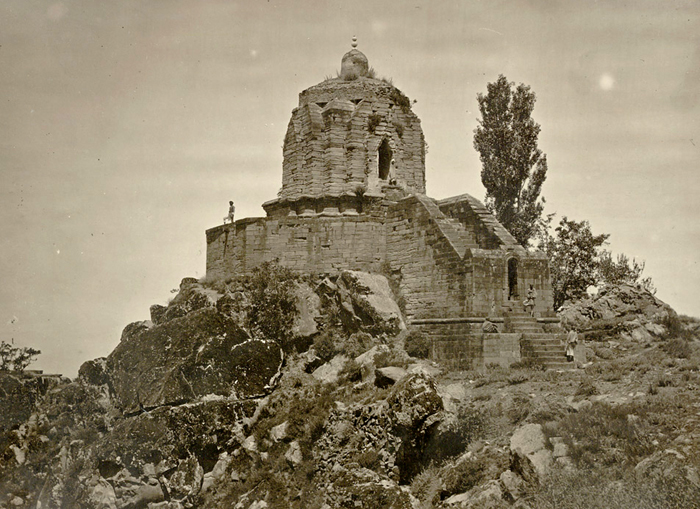
The Sankaracharya Temple in 1868
|
mukti4u2@gmail.com |
 |
www.mukti4u2.dk |
mukti4u2.dk
► created by
BP
|